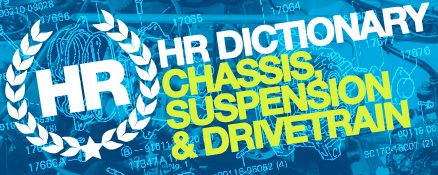
Have you ever looked at a forum, tech guide or catalogue of all those shiny bits you want for your car but the terms and abbreviations got you confused? Well with the HR dictionary you’ll never have those problems again!! In this edition we cover the ins-and-outs of chassis, suspension and drivetrain terminology relating to the AE86!
X WAY: 1, 1.5, or 2 way LSD. Refers to when and how the LSD will lock. 1 way only on accelerating forward momentum. 1.5 way on accelerating forward momentum and extreme decelerating forward momentum. 2 way both acceleration and deceleration forward momentum. Each LSD centre can be set to very soft (requiring a lot of force) or very harsh (requiring minimal force) to lock.
4 LINK: See trailing arms.
AXLE: A shaft that bolts to the rear wheels and connects to the differential. This is done via a series of splines on the end of the axle shaft.
BRAKE CALIPER: A clamping device that locks down on disc brakes for slowing momentum. The calipers use what are called pistons to push a brake pad again the disc. Calipers can have between 1-8 pistons to clamp against a disc. The more pistons you have is not necessarily going to mean better stopping power. A decent caliper will clamp a large surface area and if multiple pistons will have them evenly spread and of the same size.
BUSHING: Rubber or urethane mounting protector to reduce wear and tear on metal suspension components. Found on swaybars, trailing arms, and control arms to stop friction wear between these items its mounting points.
CAMBER: Refers to the inward angle of the wheel. Camber is added to suspension geometry to aid in steering and cornering but giving sharper turn in and greater steering speed.
CAMBER TOP: Adjustable plate at the top of a strut to allow the adjustment of camber and suspension setting. This can be a separate plate to add to struts or part of a coilover system.
CASTOR: Refers to the forward placement of the front wheels past the center steering line. Castor aids in steering response and control for circuit and drifting. The more castor you add the harder it is to initially turn the wheel but once moving it reacts very quickly.
COILOVER: Suspension system with sprung coil over a shock absorber tube. Coilovers are generally characterised by its adjustable height and perch, spring tension, rebound control. usually found as the front suspension on AE86’s and not in the rear due to its live rer axle.
CONTROL ARM: Controls the up and down, and side to side and location of the wheel to the suspension. The control arm attaches to the base of a shock absorber, the swaybar, and the front castor arms to locate the wheel in the correct position when driving.
DIFFERENTIAL: A set of gears that porportions drive to the wheels via the axles. Commonly refered to as diffs, they come in varying sizes and strengths. They also come in varying ranges of locking, see locker, LSD and open differential.
DISC BRAKES: Round and plate shaped, they are clamped by a caliper to slow momentum. Discs are much better at transferring heat and slowing momentum faster, and don’t fade as quickly as drums. The bigger the disc the larger the heat exchange area and the faster you will slow down. Best for circuit and street driving.
DRUM BRAKES: Dating back to the beginning of the 1900’s drum brakes use a shallow drum shaped cover which internal semi-circle pads or shoes push against the shallow drum to slow momentum. Drums are genreally found nowadays on the most basic of cars, but previously used fairly regularly. Drums usually are a poor braking system as no heat can escape, and fade very quickly. Great for drifting as the shoes cover a larger area than disc brake calipers, and lock quickly.
FENDER/BODY BRACE: Sits underneath body panels, usually the front or in the rear of the cabin, to aid in tying the body together to create a rigid body and chassis.
GEAR SET: The internal gears of a gearbox. Specifically refers to the actual gears you go through whilst driving. Commonly named for aftermarket sets, they are usually much much stronger and come in varying ratio’s.
HUB: The mounting point that sits on the stub axle and the disc brake and wheel bolt to. The hub is the part that attaches to the wheel and spins on the road.
LEAF SPRING: Dating back to ‘Ye Olde Dayes’ of horses and carts. A simple and rudimentary curved flat steel bars bound together with the rear diff in place of springs. Really only good for carrying weight and drag racing.
LIVE AXLE: Standard AE86 rear differential and housing. It is a diff centre and axles contained with in one singular unit that is the width of the car, with brakes at either end.
LOCKER: Locking together the centre of an open diff via welding. Locking an open diff turns it into a extremely fierce LSD that doesn’t unlock. You notice it quickly as its extremely loud and very clunky.
LSD: Limited slip differential. The centre of a rear end which receives drive via the tail shaft and sends drive to the rear wheels. The LSD locks when force is applied so both wheels turn at the same time providing more grip or slip.
NC RCA: Negative camber roll center adjuster. This is not a regular RCA because once installed it automatically adds negative camber as well as increase the track width by pushing the strut outwards similar to a camber top.
OPEN DIFF: Standard fitment on ADM, SR5, and AE85 models. Commonly referred to a ‘single spinner’ or ‘single pegger’ as most of the drive is sent to only one wheel via the diff. See locked diffs to remedy this.
PEGLEGGING/PIRATE BURNOUT: Using aforementioned single spinner diff centre to haphazardly lay rubber using only one tyre. For example; ‘He’s just peglegging’ or ‘It’s nothin’ but a pirate burnout”. Usually cheaply remedied by running a locker.
PS ARMS: Power steering arms. The power steering arm ends from the power steering rack. Usually fitted to manual steering racks for more lock and response.
RCA: Roll center adjuster. Bolted to the underside of a strut between the lower control arm (LCA) and strut to correct the lower control arms angle and correct the suspension geometry. Also helps with bump steer.
ROSE JOINT: A rotating ball joint used for its strength and manouverability. Mainly used for arms and joints where movement is possible such as trailing arms or castor arms.
SHOCK ABSORBER: a gas or oil filled pneumatic piston and tube that is part of the strut which absorbs the bumps in the road. commonly refered to shocks they are one of the 2 intergral parts of any suspension set up. they come in varying heights, sizes and force weights IE; 8kg/in 450lb/mm.
SPINDLE: see stub axle.
SPRINGS: A thick coil of metal wound into a spring that sits over the top of a shock absorber. This is the second most intergral part of a suspension set up as this reacts quicker than a shock to smooth out bumps. Again like shocks come varying heights, sizes and force weights.
STRUT: The whole suspension system including shocks, hubs and stub axles.
STRUT BRACE: A strut brace runs between the 2 front and 2 rear strut towers from one side of the car to the other. They come in varying brands and compositions but they all bind the suspension together so it acts as one unit instead of independantly.
STUB AXLE: A short metal stub mounted off the front strut that the disc brake and front hub sits on to mounting the wheels. These stubs are super strong as they need to be able to take the weight of the car and repeated abuse from the suspension and roads.
SWAYBAR: A suspension bar that aids in cornering. The swaybar normally runs from one strut to the other on either side, front and rear to aid in reducing body roll when cornering. They come in come in varying thickeness and adjustablity.
SWAYBAR LINKS: What the swaybar attatches to bolted to the control arm. The swaybar link is the locating bracket that holds the swaybar in place when cornering. They also come in adjustable links so you can increase the stiffness of your swaybar.
TAILSHAFT: Send drive from the engine and gearbox to the rear end. Factory AE86 tailshaft is 2 peice with a centre uni joint
TRAILING ARMS: Locating arms that attatch the diff housing to the body, also called 4 links. Factory trailing arms are un-equal length and come with a rubber bush. You can get aftermarket arms, which use a rose joint and are adjustable in length. Also available are equal length trailing arms but require body modifications to be fitted
TOE: Is the outward point of the front wheels to aid in high speed stability and wheel even-ness when drifting. Adding toe to the front suspension geometry aids in keeping the tread of the tyre as flat as possible when the wheels are at full lock.
URETHANE: A plastic based product used to make bushes for suspension components. Also called polythane or nolethane, it is a much more firmer and rigid bush compared to a flexible and compressable rubber bush.
Don’t worry, there’s more to be added as time goes on so if you don’t see something on here you desperately need to know, hit up the comments. Also, if you have suggestions of your own and want to share the knowledge, hit up the comments too!




3 Responses to HR Dictionary: Chassis, Suspension & Drivetrain